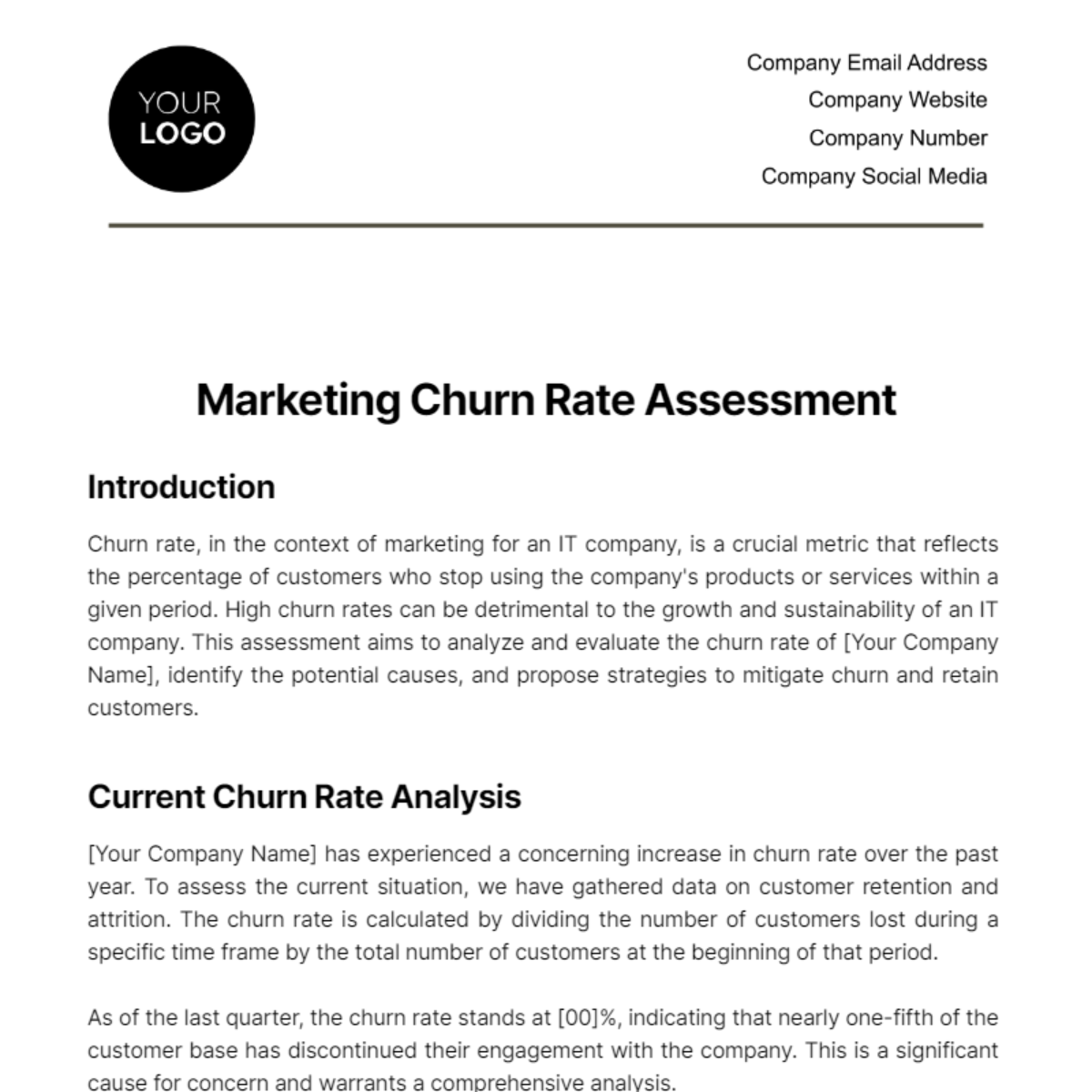Free Marketing Churn Rate Assessment

Introduction
Churn rate, in the context of marketing for an IT company, is a crucial metric that reflects the percentage of customers who stop using the company's products or services within a given period. High churn rates can be detrimental to the growth and sustainability of an IT company. This assessment aims to analyze and evaluate the churn rate of [Your Company Name], identify the potential causes, and propose strategies to mitigate churn and retain customers.
Current Churn Rate Analysis
[Your Company Name] has experienced a concerning increase in churn rate over the past year. To assess the current situation, we have gathered data on customer retention and attrition. The churn rate is calculated by dividing the number of customers lost during a specific time frame by the total number of customers at the beginning of that period.
As of the last quarter, the churn rate stands at [00]%, indicating that nearly one-fifth of the customer base has discontinued their engagement with the company. This is a significant cause for concern and warrants a comprehensive analysis.
Causes of Churn
Several factors contribute to the high churn rate observed at [Your Company Name]:
1. Lack of Customer Engagement
Insufficient communication and engagement with customers have led to decreased satisfaction and loyalty. Customers often perceive a lack of proactive support and personalization.
2. Competitive Market
The IT industry is highly competitive, and customers have numerous alternatives. Competitors offering similar services at competitive prices pose a threat.
3. Technical Issues
Frequent technical glitches and downtimes have frustrated customers, leading to cancellations. Slow response times for issue resolution have further aggravated the situation.
4. Inadequate Onboarding
New customers often face difficulties in understanding the product/service, leading to early abandonment. Onboarding and training programs need improvement.
Churn Mitigation Strategies
To address the high churn rate, [Your Company Name] should implement a combination of short-term and long-term strategies:
1. Improved Customer Engagement
Implement a customer relationship management (CRM) system to track customer interactions and preferences.
Develop personalized communication strategies, including email campaigns, webinars, and newsletters.
Create a responsive customer support team for quicker issue resolution.
2. Competitive Analysis and Pricing
Conduct regular competitive analyses to stay updated on market trends.
Consider revising pricing models to remain competitive without compromising quality.
3. Technical Upgrades
Allocate resources for infrastructure improvements to reduce technical issues and downtime.
Provide proactive updates to customers regarding system maintenance and upgrades.
4. Enhanced Onboarding
Revamp the onboarding process to make it user-friendly and informative.
Provide tutorials, documentation, and online support to assist new customers in getting started.
5. Customer Feedback Loop
Establish a feedback mechanism to understand the specific pain points and concerns of departing customers.
Use this feedback to continually improve products and services.
Monitoring and Measurement
[Your Company Name] should regularly monitor the effectiveness of these strategies by tracking key performance indicators (KPIs) such as:
Churn rate: Continuously measure and track the churn rate to ensure it is decreasing over time.
Customer satisfaction: Conduct surveys and collect feedback to gauge customer satisfaction levels.
Net Promoter Score (NPS): Measure the willingness of customers to recommend the company to others.
Conclusion
High churn rates can have a detrimental impact on the growth and sustainability of an IT company like [Your Company Name]. Addressing the causes of churn and implementing effective strategies to mitigate it is essential for retaining and expanding the customer base. By improving customer engagement, staying competitive, resolving technical issues, enhancing onboarding processes, and actively seeking feedback, [Your Company Name] can work towards reducing churn and securing a more stable and profitable future.
- 100% Customizable, free editor
- Access 1 Million+ Templates, photo’s & graphics
- Download or share as a template
- Click and replace photos, graphics, text, backgrounds
- Resize, crop, AI write & more
- Access advanced editor
Refine customer retention strategies with Template.net's Marketing Churn Rate Assessment Template. This editable and customizable tool enables thorough analysis of churn rates to optimize retention efforts. Tailor assessment criteria effortlessly using our Ai Editor Tool, ensuring precise insights. Enhance customer loyalty and reduce churn effectively with this comprehensive template.





























